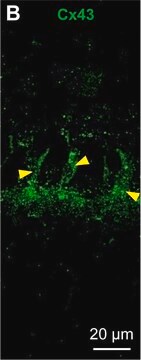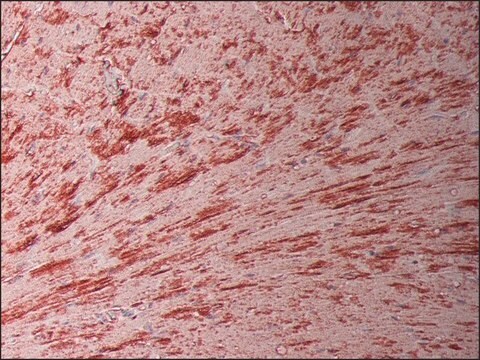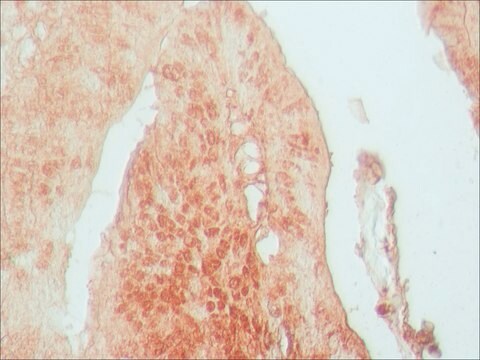C8093
Anti-Connexin 43 Antibody
mouse monoclonal, CXN-6
Sinônimo(s):
Mouse monoclonal antibody
About This Item
Produtos recomendados
product name
Monoclonal Anti-Connexin-43 antibody produced in mouse, clone CXN-6, ascites fluid
fonte biológica
mouse
Nível de qualidade
conjugado
unconjugated
forma do anticorpo
ascites fluid
tipo de produto de anticorpo
primary antibodies
clone
CXN-6, monoclonal
peso molecular
antigen 43 kDa
contém
15 mM sodium azide
reatividade de espécies
rat, hamster, bovine, mouse, human
técnica(s)
immunocytochemistry: suitable
immunohistochemistry (formalin-fixed, paraffin-embedded sections): suitable
immunohistochemistry (frozen sections): suitable
indirect ELISA: suitable
microarray: suitable
western blot: 1:8,000-1:16.000 using mouse whole brain extract
Isotipo
IgM
nº de adesão UniProt
Condições de expedição
dry ice
temperatura de armazenamento
−20°C
modificação pós-traducional do alvo
unmodified
Informações sobre genes
human ... GJA1(2697) , GJA1P1(2698)
mouse ... Gja1(14609)
rat ... Gja1(24392)
Descrição geral
Especificidade
Imunogênio
Aplicação
- fluorescent immunostaining
- western blotting
- immunocytochemistry
- preparation of immuno-affinity columns
Ações bioquímicas/fisiológicas
Exoneração de responsabilidade
Não está encontrando o produto certo?
Experimente o nosso Ferramenta de seleção de produtos.
recomendado
Código de classe de armazenamento
13 - Non Combustible Solids
Classe de risco de água (WGK)
WGK 1
Ponto de fulgor (°F)
Not applicable
Ponto de fulgor (°C)
Not applicable
Certificados de análise (COA)
Busque Certificados de análise (COA) digitando o Número do Lote do produto. Os números de lote e remessa podem ser encontrados no rótulo de um produto após a palavra “Lot” ou “Batch”.
Já possui este produto?
Encontre a documentação dos produtos que você adquiriu recentemente na biblioteca de documentos.
Nossa equipe de cientistas tem experiência em todas as áreas de pesquisa, incluindo Life Sciences, ciência de materiais, síntese química, cromatografia, química analítica e muitas outras.
Entre em contato com a assistência técnica







